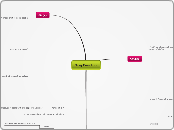Trig Functon
Cos(x)
Period of Pi
Goes to -1 and back when x = pi
Amplitude of one
Graph has max and min of one
It has a max value of 1 and min of -1 on unit circle
Same as sin(x)
Modifying phase shift can give us the Y coordinate or the graph of sin(x)
Same period
X goes to 1 the same as y goes to one
Same rate
One depends on other
Both make up the angle
When one decreases the other increases then vice versa when they hit the midpoint
Repeats itself every 2 times pi
One revolution around the unit circle
Represented by y=cos(x)
Same x coordinate when the phase shift is done
Same properties
Same amplitude
Same zeros
when phase shift is modified by pi over 2
Same Period
RRead "same Period"
Same amp
Sin(x) and cos(x) both approach 1 and -1
Can be shown in graph
Because of radius
When the value exceeds 1 and neg 1
Divide by radius
Figure out domain and modify
Is the X-Axis on the unit circle
arccos(x)
Inverse function
Backwards
Domain
Switches with range
Reverse machine
Range
Switches with domain
Reverse machine
Reverses whas cos(x) does
Can delete cos(x) in algebra
Just like logs
Handy in algebra
Just like exponents
Handy in algebra
Sin(x)
Period of Pi
Same as Cos(x)
Both go to 1 and -1
Y coordinate returns to zero
Amplitude of 1
Sin(x) can only have a maximum value of 1
If it is over 1 then you divide by radius
The unit circle radius is one
Is the Y-Axis on the Unit Circle
Because of relation to right triangle
Direct relationships with angles and Y coordinate
Sin(x) = Opposite (Y) over Hypontenuse (Radius)
Represents the Y coordinate when the triangle is graphed
Is a function of X because based on what x is sin(x) follows with a Y coordinate.
That's how you graph it
Can be modified with phase shift to equal cos(x)
It looks like cos(x) when graphed
Same amplitude because of the unit circle with radius of 1
Same max's and min's
Same Zeros
When modified by pi over two
Inverse is arcsin(x)
Is used to remove sin(x) functions
It reverses the function that is being applied to X
Very Handy in Algebra equations
It works like Logorithms
Gives us the y value and we have to find the angle measure
Its usually a friendly angle
Can be used to model various events that repeat themselves
Seasons
How the planets cycle
Tides
Tan(x)
Period of 2 Pi
Because it deals with two seperate varibles
Ratio between two
Is the x over the y points on the unit circle
Graph
Zeros
Its zeros are when sin equals 0
sin(x) over cos(x)
Sin(x) controls zero
Except when cos(x) equals zero
Asymptotes
When cos(x) equals zero
Happens at pi over two and 3pi over two
Gives undefined value
Non existent
You cannot divide by zero
arc tan(x)
Oppostite
Graph is reflected over x
Handy in algebra
Deletes tan(x)
Range
Switches with Domain
Domain
Have to be careful
Have to visualize unit circle
Confusing
Sends you to another spot on the unit circle
